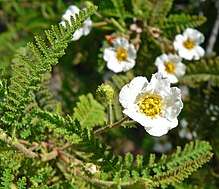Chamaebatia
Chamaebatia, also known as mountain misery, is a genus of two species of aromatic evergreen shrubs endemic to California. Its English common name derives from early settlers' experience with the plant's dense tangle and sticky, strong-smelling resin.[1][2] They are actinorhizal, non-legumes capable of nitrogen fixation through symbiosis with actinobacteria Frankia.[3][4]
| Chamaebatia | |
|---|---|
 | |
| Chamaebatia australis | |
| Scientific classification | |
| Kingdom: | Plantae |
| Clade: | Tracheophytes |
| Clade: | Angiosperms |
| Clade: | Eudicots |
| Clade: | Rosids |
| Order: | Rosales |
| Family: | Rosaceae |
| Subfamily: | Dryadoideae |
| Genus: | Chamaebatia Benth. |
| Species | |
Species
- Chamaebatia australis - Southern mountain misery
- Chamaebatia foliolosa - Sierra mountain misery, bearclover, kit-kit-dizze[1]
References
- Karen Wiese (5 February 2013). Sierra Nevada Wildflowers, 2nd: A Field Guide to Common Wildflowers and Shrubs of the Sierra Nevada. FalconGuides. p. 188. ISBN 978-0-7627-8034-1.
- Bibby, Brian; Aguilar, Dugan (2005). Deeper Than Gold: Indian Life in the Sierra Foothills. Heyday. p. 101. ISBN 978-0-930588-96-0.
- Swensen, S.M.; Mullin, B.C. (1997). "The impact of molecular systematics on hypotheses for the evolution of root nodule symbioses and implications for expanding symbioses to new host plant genera". Plant and Soil. 194: 185–192. doi:10.1023/A:1004240004063.
- Oakley, B.; North, M.; Franklin, J. F.; Hedlund, B. P.; Staley, J. T. (2004). "Diversity and Distribution of Frankia Strains Symbiotic with Ceanothus in California" (PDF). Applied and Environmental Microbiology. 70 (11): 6444–6452. doi:10.1128/AEM.70.11.6444-6452.2004. ISSN 0099-2240. PMC 525117. PMID 15528504.
Frankia strains symbiotic with Chamaebatia (Rosaceae) were within the same clade as several Ceanothus symbionts
This article is issued from Wikipedia. The text is licensed under Creative Commons - Attribution - Sharealike. Additional terms may apply for the media files.